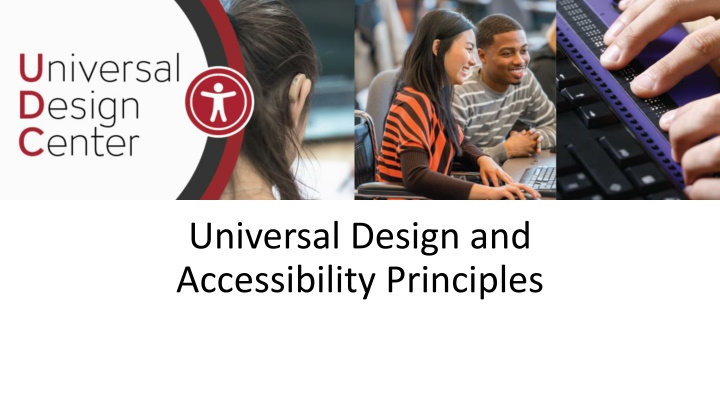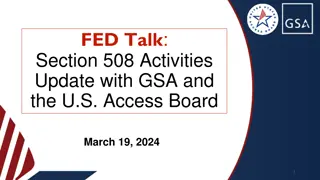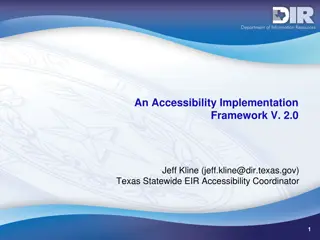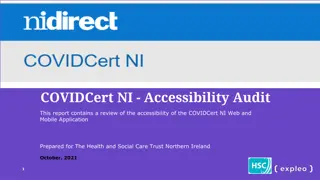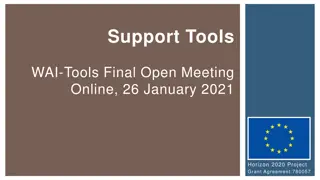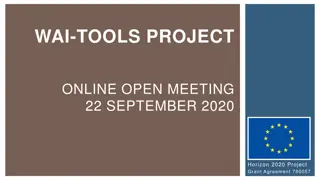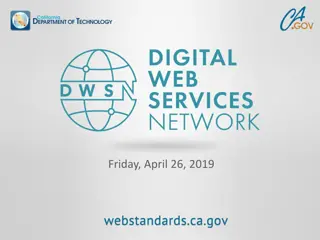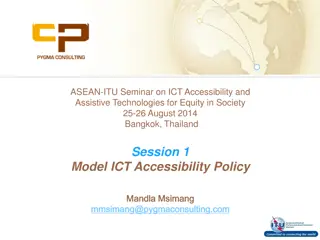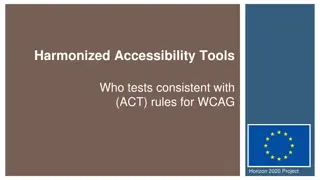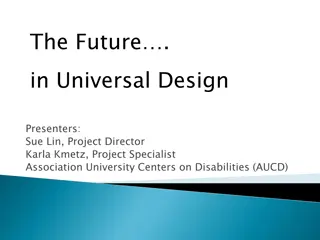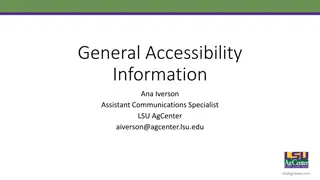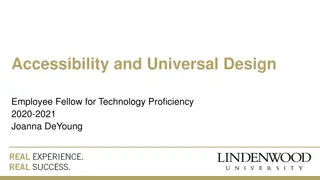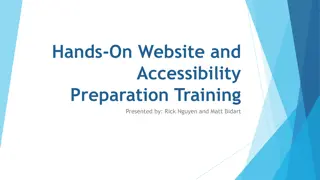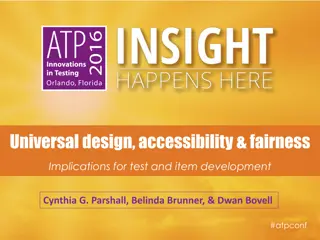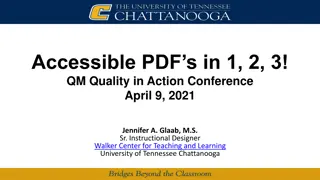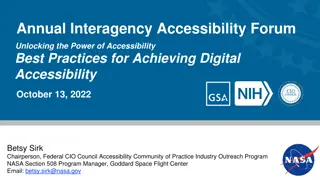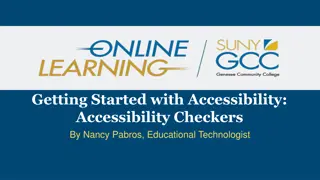Universal Design and Accessibility Principles Overview
Learn about the importance of universal design and accessibility principles in creating technology that is usable by everyone, regardless of abilities. Discover the key principles such as equitable use, flexibility in use, simplicity, perceptibility, error tolerance, low physical effort, and appropriate size and space. Understand the laws and policies governing accessibility, the need for universal design, and how to conduct an accessibility evaluation. Explore examples and guidelines for implementing universal design effectively.
Uploaded on Sep 29, 2024 | 1 Views
Download Presentation

Please find below an Image/Link to download the presentation.
The content on the website is provided AS IS for your information and personal use only. It may not be sold, licensed, or shared on other websites without obtaining consent from the author.If you encounter any issues during the download, it is possible that the publisher has removed the file from their server.
You are allowed to download the files provided on this website for personal or commercial use, subject to the condition that they are used lawfully. All files are the property of their respective owners.
The content on the website is provided AS IS for your information and personal use only. It may not be sold, licensed, or shared on other websites without obtaining consent from the author.
E N D
Presentation Transcript
Universal Design and Accessibility Principles
Goals Understand Principles of universal design Application of universal design to technology and to accessibility CSU Accessible Technology Initiative Accessibility best practices Be able to Conduct a four-point accessibility evaluation
Law and Policy "It is the policy of the CSU to make information technology resources and services accessible to all CSU students, faculty, staff and the general public regardless of disability." (E.O. 926) Accessible Technology Initiative: www.csun.edu/ati Instructional Materials Procurement Web Americans with Disabilities Act (ADA) Rehabilitation Act Amendment (Section 508) State of California Government Code Section 11135
Need for Accessibility And Universal Design 20% of the U.S. population has at least one disability (U.S. Census Bureau: Disability [2010]) 11% of college students report a disability (U.S. Department of Education, National Center for Education Statistics. [2016])
Universal Design Principles 1. Equitable use. The design is useful and marketable to people with diverse abilities. For example, a website that is designed to be accessible to everyone, including people who are blind and use screen reader technology, employs this principle. Flexibility in Use. The design accommodates a wide range of individual preferences and abilities. An example is a museum that allows visitors to choose to read or listen to the description of the contents of a display case. Simple and intuitive. Use of the design is easy to understand, regardless of the user's experience, knowledge, language skills, or current concentration level. Science lab equipment with clear and intuitive control buttons is an example of an application of this principle. Perceptible information. The design communicates necessary information effectively to the user, regardless of ambient conditions or the user's sensory abilities. An example of this principle is captioned television programming projected in a noisy sports bar. Tolerance for error. The design minimizes hazards and the adverse consequences of accidental or unintended actions. An example of a product applying this principle is software applications that provide guidance when the user makes an inappropriate selection. Low physical effort. The design can be used efficiently, comfortably, and with a minimum of fatigue. Doors that open automatically for people with a wide variety of physical characteristics demonstrate the application of this principle. Size and space for approach and use. Appropriate size and space is provided for approach, reach, manipulation, and use regardless of the user's body size, posture, or mobility. A flexible work area designed for use by employees who are left- or right-handed and have a variety of other physical characteristics and abilities is an example of applying this principle. 2. 3. 4. 5. 6. 7. Universal Design: Process, Principles, and Applications (UW)
Universal Design Principles for Information / Technology P.O.U.R. Perceivable: so that individuals with sensory impairments can understand the information being conveyed Operable: navigate to information via multiple methods (not only the mouse) Understandable: enough so that all different learning styles can engage Robust:technology should be compatible with a user s desired devices, applications or system preferences
Universal Design: Mobile Siri, Genie, etc. Dictation Predictive text Vibrating/flashing alerts Safari Reader Etc.
Best Practices Structure Alternate Text Color User Interface Navigation/Links Link Requirements Keyboard Accessibility Images Headings, lists, etc. Color contrast Meaning without color
Alternate text: Images and Videos Where possible, add a caption to an image. Captions are universal. Otherwise, add alternative text. Videos posted online or used for instruction must be captioned. Videos online need both a title and an alternative such as a link to the content. Tiny turtle eating a ripe strawberry.
Structure: headings and lists Use these:
User Interface Users should be able to get to content without using a mouse. Keyboard Hearing Touch Users should be able to access content on different screens (phone, tablet, etc.).
Navigation and Links Fix broken links. Use descriptive link text, not URLs. (Always on the web; usually in documents.) Link text should clearly identify the target of each link. Good link text should not be overly general. Do not use different link text to refer to the same resource. Do not to use the same link text to refer to different resources. Web pages with links to files that require a special reader or plug-in should contain a link to obtain the reader or plug-in.
Four-point accessibility evaluation 1. Is the text easy to read? Is the font clear? 2. How is color used? Can you read the text clearly against the background? Does color mean anything that isn t conveyed another way? 3. Can you use the keyboard tab key to navigate to all the features on the page or screen? 4. Can you enlarge the screen without distorting the text? Use Ctrl + and Ctrl - on a keyboard, or the accessibility features or gestures on your mobile device.
Reflection What s one thing you can do tomorrow to make the work you produce more accessible? What s one thing the UDC can do to make this training better?
Whats next? UDC scheduled trainings in October Web Accessibility Principles Part I: October 17thfrom 1:30 3 PM Word Accessibility Principles Part I: October 3rd from 9:30 to 11 AM and October 10th from 9:30 to 11 AM Word Accessibility Principles Part II: October 17th from 9:30 to 11 AM and October 24th from 9:30 to 11 AM
Thank you Trainings coming soon in November PDF Accessibility Principles Part I PDF Remedy Testing for Accessibility Compliance Sheriff Foundations Contact Kate Sharron, x3065, kathryn.sharron@csun.edu Alen Davoudian, x6263, alen.davoudian@csun.edu
